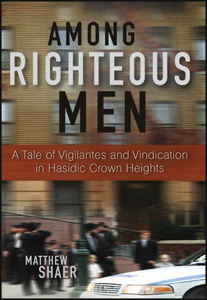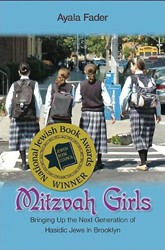Matthew Shaer will be blogging here for Jewish Book Council and MyJewishLearning all week.
 In my last blog post, I wrote about the genesis of my book, Among Righteous Men, and the emotional connection I often felt to Crown Heights, the Brooklyn neighborhood where the book is set.
In my last blog post, I wrote about the genesis of my book, Among Righteous Men, and the emotional connection I often felt to Crown Heights, the Brooklyn neighborhood where the book is set.
Suffice to say that the sense of connection did not last forever, at least not in that unalloyed state. As time wore on, and I spent increasingly more time in the neighborhood, the epiphanic moments – – I think of them now as moments of sheer electricity – – became less common. Sometimes, they were replaced sometimes by more ordinary joys: Tours through rambling Crown Heights homes, evenings in the storefront shuls and grand temples, sprawling meals with gracious hosts, small gifts of kindness from strangers who have since become friends.
Sometimes, that initial electricity was replaced by fatigue, anger, and frustration. (Hasidim have never been particularly fond of the mainstream press, and I had more doors slammed in my face than I care to count.) And sometimes it was replaced by a deep and abiding sense of alienation.
By 2009, when I signed the contract to write Among Righteous Men, the scope of the project had expanded – – I was no longer interested only in the Shmira, but also in the Shomrim, a rival group of Hasidic vigilantes competing for control of the same Crown Heights turf. The Shomrim and Shmira had once been united under a single shield, but in the late ‘90s, infighting consumed the organization, and the two groups had since set up shop on opposite ends of Crown Heights. In 2009, with the apparent help of one of the Shmira members, six Shomrim volunteers were charged with felony gang assault, in a case dating back to 2007.
According to the Brooklyn DA, the Shomrim, responding to a call of distress from a Crown Heights yeshiva dormitory, had punched, strangled, and kicked their way through a crowd of rabbinical students. The Shomrim, for their part, claimed to have been ambushed by the students, or bochurim.
The gang assault trial, which began in the fall of 2009, was a particularly painful experience for the Shomrim, who believed they had been stabbed in the back by members of their own community. Making matters worse was the fact that accusers and accused fell on opposite sides of a religious schism which had roiled Jewish Crown Heights for years.
The rabbinical students, I came to understand, were messianists, who believed that the late Lubavitcher Rebbe, Menachem Mendel Schneerson, had been the messiah– – the Jew who would usher in the second coming of man. That Schneerson was dead, and buried in Queens, did not diminish their fervor: He could still come back, they reasoned; holy men had before.
The members of the Shomrim, on the other hand, considered themselves to be moderates, who loved their Rebbe, but were embarrassed and uncertain at the fevered pronouncements of the messianists. (I want to stress that I am working here in very broad strokes. Messianist beliefs in Crown Heights, or lack thereof, fall on a wide spectrum, which encompass outspoken messianists, passive messianists, passive moderates, outspoken anti-messianists, and every stripe in between. The distinctions are sometimes described as existing on a “sliding scale.”)
In this light, the brawl at the dormitory took on a different light. It was a not just a fist-fight. It was a religious struggle – – a struggle for the soul of Crown Heights itself. This was drama, I thought. This was Shakespearian – –that adjective of choice of editors and jacket copy writers. It was a house divided. It was the Hatfields and McCoys, the Hasidic edition.
In the fall of the 2009, I spent several weeks in Brooklyn Supreme Court, observing the criminal trial against the Shomrim. (Want to know how the whole fiasco ended? Well, you’ll have to read Among Righteous Men.) I knew the trial would be the backbone of my book, but I felt there was much of Crown Heights that remained out of reach to me, and in the afternoons, after the court sessions had ended, I took the 2 train out to Crown Heights, to chat with acquaintances or hunt down additional sources.
I was frequently forced to perform strange feats in order to obtain an interview. Once, for instance, I spent an evening in an underground matzos factory, waiting for an potential source to finish firing the bread – – a scene I describe in a 2011 issue of Harper’s Magazine. I strapped on tefillin, drank a lot of vodka, recited prayers. I accompanied a Lubavitch friend and Shomrim member to the Hunts Point Market, deep in the Bronx, at half past three in the morning, in order to hear a story about a fist-fight which my friend assured me I would find very interesting indeed. (He was right.)
I was almost always treated with respect, although there were exceptions. Because my book would deal with the rift between messianists and moderates, I needed to spend time talking with both groups. And yet Crown Heights is an exceptionally small place, geographically and otherwise, and since I was always dressed in “civilian” clothes — jeans and a fleece — my progress across the neighborhood was easy to track. I regularly received phone calls from moderates, who wanted to know what the hell I was doing talking to messianists; later, a messianist would call, and ask me what the hell I was doing with a moderate. Usually, these calls were friendly, but sometimes not. I can recall vividly one instance where I returned home to my apartment, in Park Slope, where my girlfriend had prepared dinner; no sooner had I sat down than my phone began to ring.
I recognized the number — the caller was a man I had interviewed two days before. I figured he had forgotten to tell me something. But when I picked up, he unleashed a barrage of profanities, beginning with motherfucker and ending with motherfucking traitor. As it turned out, he had assumed I was sympathetic to the messianist cause, but his cousin — “a man I trust and love, a good man” — had seen me “palling around” with a bunch of “no-good mossers,” or “rats.” Moderates, in other words.
“You should be very careful,” the man told me.
“Thank you,” I said. “I will.”
“Because,” he added, “there’s always someone watching. Do you get what I’m saying?”
“Yes,” I said, and hung up. I must have blanched considerably, because my girlfriend eyed me worriedly, and reached across the table to take my hand. “Are you OK?” she said.
I was, but the whole incident helped take the sheen off the kinetic connection I had first felt to Crown Heights. Of course, as I should have known from the beginning, despite the religious and historical aura that surrounds the neighborhood, Crown Heights is really just a world like any other, full of terrible joys and also the usual bitterness and anger.
Matthew Shaer is the author of Among Righteous Men. His writing has appeared in Harper’s, Foreign Policy, andThe Washington Post, among other publications. He is a regular contributor to New York magazine. He tweets at @MatthewShaer.


